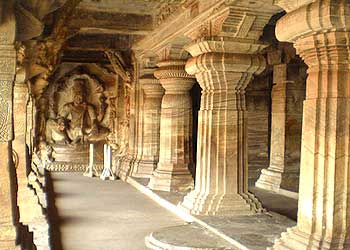Name of the Temple |
- Bādāmi Cave Temples (4 caves)
|
Location |
|
| How to reach there? |
- By Air : Hubḷi airport is the nearest to Bādhāmi caves. It is around 100 km away. From the airport take the National Highway 218 north.
- By Train : Bādhāmi railway station is 5 km north from the Bādhāmi caves.
- By Road : Bādhāmi is well connected through the National Highway 218 from Bijāpur to Hubḷi and the State Highway 14 from Eraṭṭupeṭṭa to Paṭṭihanam junction.
|
Rulers/builders and Time Period |
- Chāḷukya - Pulakesin I, 6th century A.D.
|
Deities’ - Goddess |
- Cave 1 to Lord Śhiva
- Cave 2 and 3 to Lord Viṣhṇu. Lord Vishnu depicted here as a dwarf or 'Thrivikrama' of awesome dimensions with one foot mastering the Earth and the other the sky, in the second cave is atop a sandstone hill.
|
Architecture Style |
- The Chalukyas are to be acknowledged with path-finding a new architectural style. This new style combined the best of two distinct styles - the North Indian, Indo-Aryan Nagara style and the South Indian Dravidian style. Known as the Chalukyan style, this style is manifested in many cave temples, dedicated to Brahmanical deities, as well as the many Buddhist and Jain monasteries in the region.
- The first cave made of red sandstone, dates back to 578 A.D. and was probably the first to be carved. One has to climb up 40 odd steps to reach the colonnaded verandah, a hall with numerous pillars and a square shaped sanctum hollowed in the control back wall.
- Still going higher up one comes across this cave antedating 578 A.D. The facade of the cave is nearly 70 feet wide, on the plinth one can see the carvings of gaṇas.
- The sheer artistry and sculptural genius makes this cave the highlight of Deccan art.The only Jain cave, the construction of Cave four started in the 6th century and completed after nearly 100 years later then the earlier three caves.
|
Special Reference to Fine Arts |
- The cave temples also bear exquisite carvings, sculptures and beautiful murals.
- The idol of Vāthāpi Gaṇapathi is now in Tiruchenkāṭankuḍi near Thanjāvūr of Tamilnāḍu . In 7th century, Vāthāpi Gaṇapathi idol was brought from Bādhāmi (Vāthāpi - Chālukya capital) by Siruthonḍar(General of Pallavas) who defeated Chālukyas .
- Important part of historical heritage at Bādhāmi cave temples are inscriptions in old Kannada script.
|
Other Special Features |
- There is also the fifth cave temple in Bādhāmi – Buddhist temple in natural cave which can be entered only on all fours.
|
Special Reference to Performing Arts |
- In Carnātic music, in Rāga Hamsadhhwani, the Vāthāpi Ganapathim Bhaje song, by the composer Mutthuswāmi Dīkṣhithar, is about this place and the deity here.
|
Bibliography |
|















